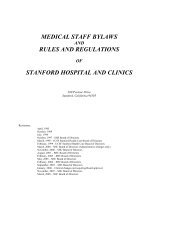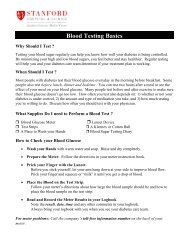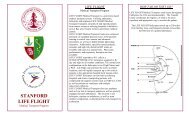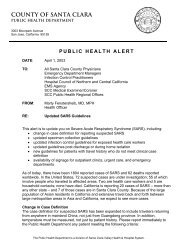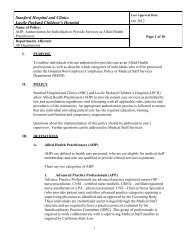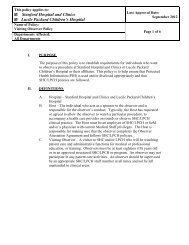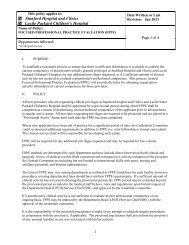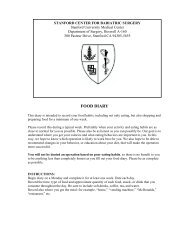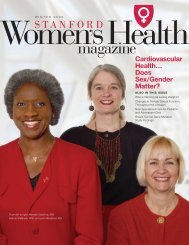Fall/Winter 2007 - Stanford Hospital & Clinics
Fall/Winter 2007 - Stanford Hospital & Clinics
Fall/Winter 2007 - Stanford Hospital & Clinics
Create successful ePaper yourself
Turn your PDF publications into a flip-book with our unique Google optimized e-Paper software.
S tanford ACCESS <strong>Fall</strong>/<strong>Winter</strong> <strong>2007</strong><br />
“We pay particular attention<br />
to risk factors known<br />
to be important in women<br />
such as a low HDL, high<br />
triglycerides, and excess<br />
weight contributing to insulin<br />
resistance and diabetes”<br />
treatment of cardiovascular disease.<br />
“Our experience so far is that<br />
women are becoming increasingly<br />
aware that they have unique issues<br />
when it comes to cardiovascular<br />
health, and they are seeking<br />
providers who are attuned to these<br />
sex-based differences.”<br />
As a cardiovascular clinic, Women’s<br />
Heart Health at <strong>Stanford</strong> is aimed at<br />
those women with known or suspected<br />
CVD.“The presentations for<br />
heart disease that we have traditionally<br />
called ‘atypical’ are often very<br />
EXCEPTIONAL CME<br />
PROGRAMMING OFFERED<br />
BY STANFORD HOSPITAL<br />
& CLINICS’ DEPARTMENT<br />
OF CONTINUING MEDICAL<br />
EDUCATION<br />
www.cme.stanfordhospital.com<br />
(650) 724-9549<br />
shc-cme@stanfordmed.org<br />
GI Cancers<br />
October 18-20, <strong>2007</strong><br />
Mauna Lani Resort, Kohala Coast,<br />
Big Island of Hawaii<br />
2nd Annual Cardiology for<br />
the Internist: Clinical Update<br />
October 27, <strong>2007</strong><br />
Four Seasons Hotel, Palo Alto,<br />
California<br />
Reconstructive Surgery at<br />
<strong>Stanford</strong>: Craniofacial Update<br />
November 3, <strong>2007</strong><br />
Hotel Sofitel, Redwood City, California<br />
Electrophysiology in the West<br />
Summit<br />
November 30-December 2, <strong>2007</strong><br />
La Playa Hotel, Carmel, California<br />
typical for women. We hear them in<br />
our clinic all of the time.” The women’s<br />
clinic orders diagnostic tests<br />
that are felt to be most accurate in<br />
women and will perform coronary<br />
angiography when deemed appropriate.<br />
“Women are less likely than men<br />
to have obstructive coronary disease<br />
on angiography, but may be more<br />
likely to have vascular abnormalities<br />
such as endothelial dysfunction and<br />
Hand Surgery at Tahoe<br />
January 25-27, 2008<br />
Hyatt Lake Tahoe, Incline Village,<br />
Nevada<br />
21st Annual Anesthesia<br />
Update<br />
February 17-22, 2008<br />
Big Sky Resort, Big Sky, Montana<br />
<strong>Stanford</strong> Morbid Obesity<br />
Update<br />
March 3-5, 2008<br />
Turtle Bay Resort, Oahu, Hawaii<br />
3rd Annual Complex<br />
Cardiovascular Patient<br />
Management<br />
May 19-21, 2008<br />
Oahu, Hawaii<br />
Bi-Annual Urogynecology<br />
Update<br />
August 1, 2008<br />
<strong>Stanford</strong>, California<br />
For more information:<br />
www.cme.stanfordhospital.com<br />
(650) 724-9549<br />
email shc-cme@stanfordmed.org<br />
microvascular disease,” reports Dr.<br />
Tremmel. “We test for these abnormalities<br />
in the cath lab in symptomatic<br />
patients whose coronary arteries<br />
appear normal. Telling patients<br />
with angina-like symptoms and normal<br />
appearing coronary arteries that<br />
there’s nothing wrong with their<br />
heart may be very inaccurate.” It also<br />
leads to frustration in both the physician<br />
and patient when no other etiology<br />
can be found. Currently, invasive<br />
diagnostic vascular function studies<br />
are performed only at select hospitals<br />
around the country. Patients coming<br />
to <strong>Stanford</strong> are offered this state-ofthe-art<br />
approach, which can be<br />
extremely helpful in guiding treatment<br />
when abnormalities are found.<br />
All women coming to Women’s<br />
Heart Health at <strong>Stanford</strong> receive a<br />
comprehensive risk assessment and<br />
are counseled on lifestyle and risk<br />
factor modification. “We pay particular<br />
attention to risk factors known to<br />
be important in women such as a low<br />
HDL, high triglycerides, and excess<br />
weight contributing to insulin resistance<br />
and diabetes,” says Mary Nejedly,<br />
the clinic’s nurse practitioner.<br />
Helping women to understand their<br />
risk and getting them to be proactive<br />
in following a healthy diet and exercising<br />
regularly is a major focus. “We<br />
also address psychosocial issues such<br />
as stress, anxiety, and depression,<br />
which are often overlooked, and are<br />
5





